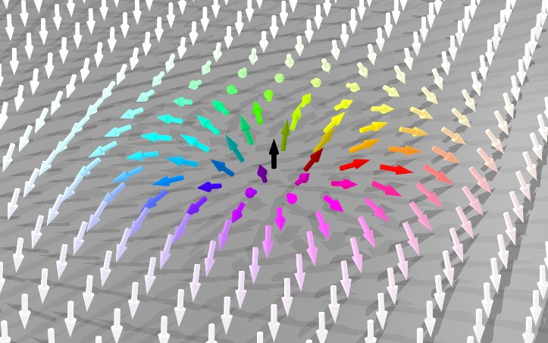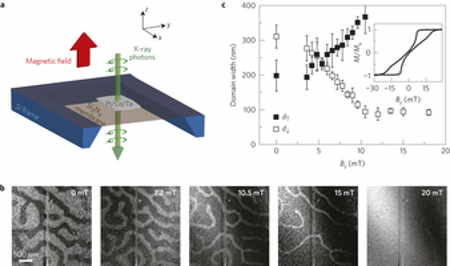R&D: Johannes Gutenberg University Mainz and MIT Achieve Controlled Movement of Skyrmions
Basis for utilization of skyrmions for application-related systems/magnetic vortices as data storage media of future
By Francis Pelletier | March 17, 2016 at 3:02 pmFrom: Johannes Gutenberg University Mainz
A joint research project being undertaken by Johannes Gutenberg University Mainz (JGU) and the Massachusetts Institute of Technology (MIT) has achieved a breakthrough in fundamental research in the field of potential future data storage technologies.

The idea is that electronic storage units (bits) will not be stored on rotating hard disks as is currently standard practice but on a nanowire in the form of magnetic vortex structures, so-called skyrmions, using a process similar to that of a shift register. The magnetic skyrmion bits would be rapidly accessible, while storage density would be high and there would be improved energy efficiency. The project team managed, for the first time, to achieve targeted shifting of individual skyrmions at room temperature using electrical impulses. Their results have been published in the journal Nature Materials.
Magnetic skyrmions are special spin configurations that can occur in materials and particularly in thin layer structures when the inversion symmetry is broken. With regard to the systems that are of interest here, this means that a thin metal film with a non-symmetrical layer structure can be employed. In materials such as this, spin configurations that behave rather like a hair whorl can form. It can be just as difficult to eradicate a skyrmion as it can be to smooth out a hair whorl, a property that gives skyrmions enhanced stability.
An important characteristic of skyrmions is that they can exist in isolation in magnetic materials and generally do not tend to collide with the edge of a structure. This provides them with the unique ability to skirt any isolated defects or unevenness in the material with which other magnetic structures, such as domain walls, would collide. Skyrmions are therefore excellent candidates for use with magnetic shift registers, otherwise known as racetrack memory. Information could be encoded in the form of skyrmions and an electrical current could be employed to move them past fixed read/write heads. The process would be both rapid and completely independent of movable mechanical components and thus ideally suited for mobile applications.
During the project, it was demonstrated that individual skyrmions can indeed be moved in a controlled manner along a magnetic wire, i.e., the so-called racetrack, by exposing them to brief electrical impulses at room temperature. In addition, new methods to describe their dynamics were developed and confirmed by experimentation. This work can thus be regarded as laying down the cornerstone for the future use of skyrmions in application-related systems.
“It is always great to see when a joint project quickly leads to exciting results. This is particularly true in this case, as we have been able to produce this journal article within just a year of entering into our cooperation agreement. It would never have come about had it not been for the close collaboration between Mainz University and MIT and the lively exchange of ideas,” said Kai Litzius, co-author of the article. Litzius is on a stipendiary scholarship awarded by the Graduate School of Excellence ‘Materials Science in Mainz’ (MAINZ) and is a member of the team headed by professor Mathias Kläui.
“I’m delighted by the way we were able to work efficiently and continuously with groups at MIT. After receiving start-up funding through a joint project financed by the German Federal Ministry of Education and Research, we have been able to produce six joint publications since 2014, partly as the result of several student visits to MIT,” emphasized Kläui, a professor at the Institute of Physics and the director of the MAINZ Graduate School of Excellence.
Establishment of the MAINZ Graduate School was approved through the Excellence Initiative by the German Federal and State Governments to Promote Science and Research at German Universities in 2007 and its funding was extended in the second round in 2012. It consists of work groups from Johannes Gutenberg University Mainz, TU Kaiserslautern, and the Max Planck Institute for Polymer Research in Mainz. One of its focal research areas is spintronics, where cooperation with leading international partners plays an important role.
Article :
Nature Materials has published an article written by Seonghoon Woo, Department of Materials Science and Engineering, Massachusetts Institute of Technology, Cambridge, Massachusetts 02139, USA, Kai Litzius, Institut für Physik, Johannes Gutenberg-Universität Mainz, 55099 Mainz, Germany, and Graduate School of Excellence Materials Science in Mainz, Staudinger Weg 9, 55128 Mainz, Germany, Benjamin Krüger, Institut für Physik, Johannes Gutenberg-Universität Mainz, 55099 Mainz, Germany, Mi-Young Im, Center for X-ray Optics, Lawrence Berkeley National Laboratory, Berkeley, California 94720, USA, and Daegu Gyeongbuk Institute of Science and Technology, Daegu 711-873, Korea, Lucas Caretta, Department of Materials Science and Engineering, Massachusetts Institute of Technology, Cambridge, Massachusetts 02139, USA, Kornel Richter, Institut für Physik, Johannes Gutenberg-Universität Mainz, 55099 Mainz, Germany, Maxwell Mann, Department of Materials Science and Engineering, Massachusetts Institute of Technology, Cambridge, Massachusetts 02139, USA, Andrea Krone, Robert M. Reeve, Institut für Physik, Johannes Gutenberg-Universität Mainz, 5509 Mainz, Germany, Markus Weigand, Max Planck Institute for Intelligent Systems, 70569 Stuttgart, Germany, Parnika Agrawal, Ivan Lemesh, Department of Materials Science and Engineering, Massachusetts Institute of Technology, Cambridge, Massachusetts 02139, USA, Mohamad-Assaad Mawass, Institut für Physik, Johannes Gutenberg-Universität Mainz, 55099 Mainz, Germany, and Max Planck Institute for Intelligent Systems, 70569 Stuttgart, Germany, Peter Fischer, Materials Sciences Division, Lawrence Berkeley National Laboratory, Berkeley, California 94720, USA, and Department of Physics, University of California, Santa Cruz, California 94056, USA, Mathias Kläui, Institut für Physik, Johannes Gutenberg-Universität Mainz, 55099 Mainz, Germany, and Graduate School of Excellence Materials Science in Mainz, Staudinger Weg 9, 55128 Mainz, Germany, and Geoffrey S. D. Beach, Department of Materials Science and Engineering, Massachusetts Institute of Technology, Cambridge, Massachusetts 02139, USA.
Figure 1: Soft X-ray imaging of domain structure
a, Schematic of MTXM geometry. b, Series of MTXM images
acquired after negative field saturation for several increasing
fields Bz > 0 for a continuous Pt/Co/Ta film.
Dark and light contrast correspond to magnetization oriented up (along…
Abstract : “Magnetic skyrmions are topologically protected spin textures that exhibit fascinating physical behaviours and large potential in highly energy-efficient spintronic device applications. The main obstacles so far are that skyrmions have been observed in only a few exotic materials and at low temperatures, and fast current-driven motion of individual skyrmions has not yet been achieved. Here, we report the observation of stable magnetic skyrmions at room temperature in ultrathin transition metal ferromagnets with magnetic transmission soft X-ray microscopy. We demonstrate the ability to generate stable skyrmion lattices and drive trains of individual skyrmions by short current pulses along a magnetic racetrack at speeds exceeding 100 ms as required for applications. Our findings provide experimental evidence of recent predictions and open the door to room-temperature skyrmion spintronics in robust thin-film heterostructures.”













 Subscribe to our free daily newsletter
Subscribe to our free daily newsletter
